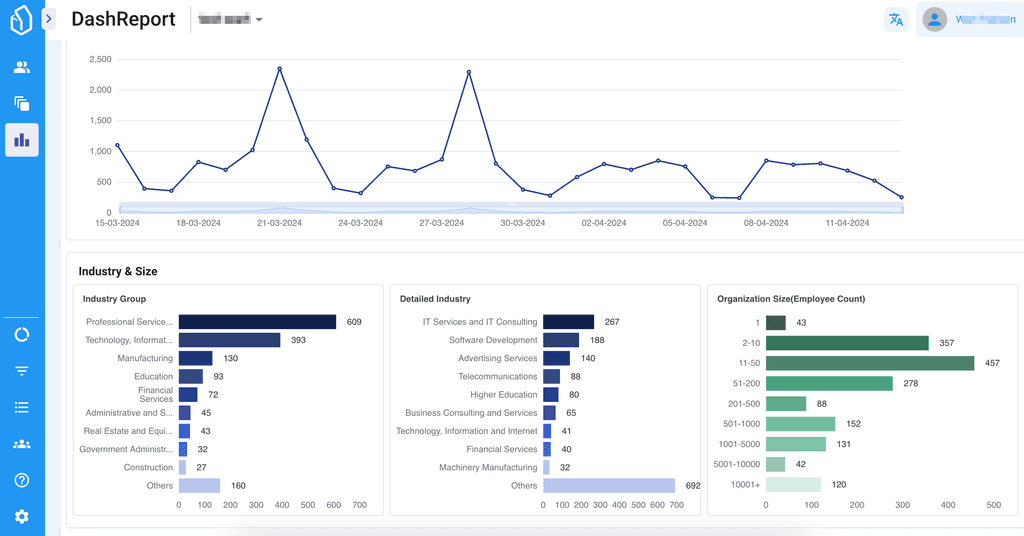
Sales
Why Your Sales Team Should Be Using Slack
Why Your Sales Team Should Be Using Slack
2016-06-15

Sales
Why Your Sales Team Should Be Using Slack
2016-06-15

Sales
Why Your Sales Team Should Be Using Slack
2016-06-15
Table of Contents
Auto Generated TOC
Auto Generated TOC
Auto Generated TOC
Auto Generated TOC
Slack has grown insanely fast, something we have previously covered in great detail.
One of the reasons why Slack likely grew so fast is because it has proven to be a fantastic way for companies to make communication and workflows much more smooth.
While Slack continues to get new users, it largely appeals to some teams within organizations over others. One team that seems to typically adopt Slack slower than others are sales teams
If you run a company and want to encourage your sales team to effectively use Slack, this post is for you and your team. We are going to explain ways that you can do some of the following using Slack:
Have greater transparency across your entire organization.
Have more ways to discover sales opportunities.
Decrease the amount of emails sent.
Increase the speed that leads are contact.
More easily share information across the entire sales team, to reduce duplicate emails.
You get the gist… Slack WILL improve your organization and the efforts of your sales team.
Making the sales team adopt Slack
This may feel aggressive, but you could make a policy that the sales team must only use Slack to communicate.
Members of your sales team may initially not like this idea, but they’ll quickly see that it makes the speed of responses to and from colleagues much quicker and also greatly reduces the amount of long email chains that they are part of.
One of the biggest benefits of getting your sales team to use lack is improved communication with other teams. Some ways that a sales team can improve their communication with other teams, using Slack, are:
When the sales team has a question for the product or development team.
When the sales team wants to request something from the marketing team.
When the sales team wants to ask a question regarding a customer to the support team.
Problem solving with Slack
Once the sales team has adopted Slack, it will make problem solving much easier. For example, if there’s a snag in a deal closing, it will be easy for a member of sales team to browse chat history to identify strategies and tactics that have been used in the past to solve similar problems.
This is valuable because it means that it is easier for people within your company to learn from their teammates, reducing the amount of mistakes made.
Less mistakes happen because communication increases
When you communicate in public channels, you get access to a searchable archive of past conversations, decisions, and deals. A few sales workflows that Slack recommends are:
Onboarding new team members: Invite new team members to important sales channels. By following existing channels, it will bring new hires up to speed rapidly.
Offboarding team members: Using Slack makes offboarding much more graceful. This is because if a person leaves the sales team, their information won’t get archived away and lost forever.
Account transactions: If you invite people, such as an account manager or customer success manager, to important sales channels, they can better track the closing and progression of deals.
Important customer information can go directly into Slack
We believe that one of the biggest advantages of Slack is the ability to seamlessly bring important customer information directly into Slack.
For example, if you get a lead on LeadBoxer that has a high leadscore, you can set up a customer notification using the LeadBoxer and Zapier integration. A high leadscore means that a lead is very qualified, and your entire sales team will be privy to this valuable information.
The ability to automatically send new leads to relevant account managers or user groups is insanely valuable and saves you a lot of time. You'll no longer need to constantly switch between a CRM, email, and Slack. Everything will be in one place (on Slack!).
Why else should your sales team be using Slack?
It’s honestly pretty difficult to answer this question because most organizations seem to find their own unique ways to use Slack. We suggest taking the plunge and seeing how your employees start using Slack. From there, you can decide on how to create the workflows that work best for your team and company.
Slack has grown insanely fast, something we have previously covered in great detail.
One of the reasons why Slack likely grew so fast is because it has proven to be a fantastic way for companies to make communication and workflows much more smooth.
While Slack continues to get new users, it largely appeals to some teams within organizations over others. One team that seems to typically adopt Slack slower than others are sales teams
If you run a company and want to encourage your sales team to effectively use Slack, this post is for you and your team. We are going to explain ways that you can do some of the following using Slack:
Have greater transparency across your entire organization.
Have more ways to discover sales opportunities.
Decrease the amount of emails sent.
Increase the speed that leads are contact.
More easily share information across the entire sales team, to reduce duplicate emails.
You get the gist… Slack WILL improve your organization and the efforts of your sales team.
Making the sales team adopt Slack
This may feel aggressive, but you could make a policy that the sales team must only use Slack to communicate.
Members of your sales team may initially not like this idea, but they’ll quickly see that it makes the speed of responses to and from colleagues much quicker and also greatly reduces the amount of long email chains that they are part of.
One of the biggest benefits of getting your sales team to use lack is improved communication with other teams. Some ways that a sales team can improve their communication with other teams, using Slack, are:
When the sales team has a question for the product or development team.
When the sales team wants to request something from the marketing team.
When the sales team wants to ask a question regarding a customer to the support team.
Problem solving with Slack
Once the sales team has adopted Slack, it will make problem solving much easier. For example, if there’s a snag in a deal closing, it will be easy for a member of sales team to browse chat history to identify strategies and tactics that have been used in the past to solve similar problems.
This is valuable because it means that it is easier for people within your company to learn from their teammates, reducing the amount of mistakes made.
Less mistakes happen because communication increases
When you communicate in public channels, you get access to a searchable archive of past conversations, decisions, and deals. A few sales workflows that Slack recommends are:
Onboarding new team members: Invite new team members to important sales channels. By following existing channels, it will bring new hires up to speed rapidly.
Offboarding team members: Using Slack makes offboarding much more graceful. This is because if a person leaves the sales team, their information won’t get archived away and lost forever.
Account transactions: If you invite people, such as an account manager or customer success manager, to important sales channels, they can better track the closing and progression of deals.
Important customer information can go directly into Slack
We believe that one of the biggest advantages of Slack is the ability to seamlessly bring important customer information directly into Slack.
For example, if you get a lead on LeadBoxer that has a high leadscore, you can set up a customer notification using the LeadBoxer and Zapier integration. A high leadscore means that a lead is very qualified, and your entire sales team will be privy to this valuable information.
The ability to automatically send new leads to relevant account managers or user groups is insanely valuable and saves you a lot of time. You'll no longer need to constantly switch between a CRM, email, and Slack. Everything will be in one place (on Slack!).
Why else should your sales team be using Slack?
It’s honestly pretty difficult to answer this question because most organizations seem to find their own unique ways to use Slack. We suggest taking the plunge and seeing how your employees start using Slack. From there, you can decide on how to create the workflows that work best for your team and company.
Slack has grown insanely fast, something we have previously covered in great detail.
One of the reasons why Slack likely grew so fast is because it has proven to be a fantastic way for companies to make communication and workflows much more smooth.
While Slack continues to get new users, it largely appeals to some teams within organizations over others. One team that seems to typically adopt Slack slower than others are sales teams
If you run a company and want to encourage your sales team to effectively use Slack, this post is for you and your team. We are going to explain ways that you can do some of the following using Slack:
Have greater transparency across your entire organization.
Have more ways to discover sales opportunities.
Decrease the amount of emails sent.
Increase the speed that leads are contact.
More easily share information across the entire sales team, to reduce duplicate emails.
You get the gist… Slack WILL improve your organization and the efforts of your sales team.
Making the sales team adopt Slack
This may feel aggressive, but you could make a policy that the sales team must only use Slack to communicate.
Members of your sales team may initially not like this idea, but they’ll quickly see that it makes the speed of responses to and from colleagues much quicker and also greatly reduces the amount of long email chains that they are part of.
One of the biggest benefits of getting your sales team to use lack is improved communication with other teams. Some ways that a sales team can improve their communication with other teams, using Slack, are:
When the sales team has a question for the product or development team.
When the sales team wants to request something from the marketing team.
When the sales team wants to ask a question regarding a customer to the support team.
Problem solving with Slack
Once the sales team has adopted Slack, it will make problem solving much easier. For example, if there’s a snag in a deal closing, it will be easy for a member of sales team to browse chat history to identify strategies and tactics that have been used in the past to solve similar problems.
This is valuable because it means that it is easier for people within your company to learn from their teammates, reducing the amount of mistakes made.
Less mistakes happen because communication increases
When you communicate in public channels, you get access to a searchable archive of past conversations, decisions, and deals. A few sales workflows that Slack recommends are:
Onboarding new team members: Invite new team members to important sales channels. By following existing channels, it will bring new hires up to speed rapidly.
Offboarding team members: Using Slack makes offboarding much more graceful. This is because if a person leaves the sales team, their information won’t get archived away and lost forever.
Account transactions: If you invite people, such as an account manager or customer success manager, to important sales channels, they can better track the closing and progression of deals.
Important customer information can go directly into Slack
We believe that one of the biggest advantages of Slack is the ability to seamlessly bring important customer information directly into Slack.
For example, if you get a lead on LeadBoxer that has a high leadscore, you can set up a customer notification using the LeadBoxer and Zapier integration. A high leadscore means that a lead is very qualified, and your entire sales team will be privy to this valuable information.
The ability to automatically send new leads to relevant account managers or user groups is insanely valuable and saves you a lot of time. You'll no longer need to constantly switch between a CRM, email, and Slack. Everything will be in one place (on Slack!).
Why else should your sales team be using Slack?
It’s honestly pretty difficult to answer this question because most organizations seem to find their own unique ways to use Slack. We suggest taking the plunge and seeing how your employees start using Slack. From there, you can decide on how to create the workflows that work best for your team and company.
Slack has grown insanely fast, something we have previously covered in great detail.
One of the reasons why Slack likely grew so fast is because it has proven to be a fantastic way for companies to make communication and workflows much more smooth.
While Slack continues to get new users, it largely appeals to some teams within organizations over others. One team that seems to typically adopt Slack slower than others are sales teams
If you run a company and want to encourage your sales team to effectively use Slack, this post is for you and your team. We are going to explain ways that you can do some of the following using Slack:
Have greater transparency across your entire organization.
Have more ways to discover sales opportunities.
Decrease the amount of emails sent.
Increase the speed that leads are contact.
More easily share information across the entire sales team, to reduce duplicate emails.
You get the gist… Slack WILL improve your organization and the efforts of your sales team.
Making the sales team adopt Slack
This may feel aggressive, but you could make a policy that the sales team must only use Slack to communicate.
Members of your sales team may initially not like this idea, but they’ll quickly see that it makes the speed of responses to and from colleagues much quicker and also greatly reduces the amount of long email chains that they are part of.
One of the biggest benefits of getting your sales team to use lack is improved communication with other teams. Some ways that a sales team can improve their communication with other teams, using Slack, are:
When the sales team has a question for the product or development team.
When the sales team wants to request something from the marketing team.
When the sales team wants to ask a question regarding a customer to the support team.
Problem solving with Slack
Once the sales team has adopted Slack, it will make problem solving much easier. For example, if there’s a snag in a deal closing, it will be easy for a member of sales team to browse chat history to identify strategies and tactics that have been used in the past to solve similar problems.
This is valuable because it means that it is easier for people within your company to learn from their teammates, reducing the amount of mistakes made.
Less mistakes happen because communication increases
When you communicate in public channels, you get access to a searchable archive of past conversations, decisions, and deals. A few sales workflows that Slack recommends are:
Onboarding new team members: Invite new team members to important sales channels. By following existing channels, it will bring new hires up to speed rapidly.
Offboarding team members: Using Slack makes offboarding much more graceful. This is because if a person leaves the sales team, their information won’t get archived away and lost forever.
Account transactions: If you invite people, such as an account manager or customer success manager, to important sales channels, they can better track the closing and progression of deals.
Important customer information can go directly into Slack
We believe that one of the biggest advantages of Slack is the ability to seamlessly bring important customer information directly into Slack.
For example, if you get a lead on LeadBoxer that has a high leadscore, you can set up a customer notification using the LeadBoxer and Zapier integration. A high leadscore means that a lead is very qualified, and your entire sales team will be privy to this valuable information.
The ability to automatically send new leads to relevant account managers or user groups is insanely valuable and saves you a lot of time. You'll no longer need to constantly switch between a CRM, email, and Slack. Everything will be in one place (on Slack!).
Why else should your sales team be using Slack?
It’s honestly pretty difficult to answer this question because most organizations seem to find their own unique ways to use Slack. We suggest taking the plunge and seeing how your employees start using Slack. From there, you can decide on how to create the workflows that work best for your team and company.

Generate More Qualified Leads with LeadBoxer
Create a (free) account or get a demo and find out how we can help you.

Generate More Qualified Leads with LeadBoxer
Create a (free) account or get a demo and find out how we can help you.

Generate More Qualified Leads with LeadBoxer
Create a (free) account or get a demo and find out how we can help you.

Generate More Qualified Leads with LeadBoxer
Create a (free) account or get a demo and find out how we can help you.
Get Started with LeadBoxer
LeadBoxer can help you quickly generate more leads
Get more insight into your online audience and their behaviour, and turn this data into actual opportunities.
Start Now!
Get Started with LeadBoxer
LeadBoxer can help you quickly generate more leads
Get more insight into your online audience and their behaviour, and turn this data into actual opportunities.
Start Now!
Get Started with LeadBoxer
LeadBoxer can help you quickly generate more leads
Get more insight into your online audience and their behaviour, and turn this data into actual opportunities.
Start Now!
Get Started with LeadBoxer
LeadBoxer can help you quickly generate more leads
Get more insight into your online audience and their behaviour, and turn this data into actual opportunities.
Start Now!
Other content in category
Sales



CRM vs. Lead Management System



How to Collect High-Quality Sales Leads



How Employment Engagement Essentially Drives B2B Sales Growth



Successful Sales Outreach Using AI & ChatGPT



Boost Client Relations with Key Account Management in B2B

Supercharge your marketing results with LeadBoxer!
Analyze campaigns and traffic, segement by industry, drilldown on company size and filter by location. See your Top pages, top accounts, and many other metrics.


Supercharge your marketing results with LeadBoxer!
Analyze campaigns and traffic, segement by industry, drilldown on company size and filter by location. See your Top pages, top accounts, and many other metrics.


Supercharge your marketing results with LeadBoxer!
Analyze campaigns and traffic, segement by industry, drilldown on company size and filter by location. See your Top pages, top accounts, and many other metrics.


Supercharge your marketing results with LeadBoxer!
Analyze campaigns and traffic, segement by industry, drilldown on company size and filter by location. See your Top pages, top accounts, and many other metrics.


